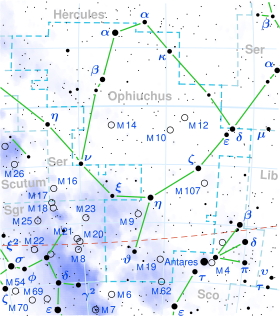오피우치 무
Mu Ophiuchi| 관측 데이터 에폭 J2000 이쿼녹스 J2000 | |
|---|---|
| 별자리 | 오푸치우스 |
| 우측 상승 | 17h 37m 50.71308s[1] |
| 탈위임 | −8° 07′ 07.5749″[1] |
| 겉보기 크기 (V) | 4.62[2] |
| 특성. | |
| 스펙트럼형 | B8II-IIIp:Mn[3] |
| U-B색지수 | −0.20[2] |
| B-V색지수 | +0.11[2] |
| 아스트로메트리 | |
| 방사 속도 (Rv) | -18.50km[4]/s |
| 고유 운동 (μ) | RA: -11.31마스[5]/yr Dec.: -20.47마스[5]/yr |
| 시차 (π) | 4.32 ± 0.20[5] mas |
| 거리 | 750 ± 30 리 (230 ± 10 pc) |
| 절대치수 (MV) | -2.24[6] |
| 세부 사항 | |
| 반지름 | 11.1+2.1 −0.6[1] R☉ |
| 루미도 | 398.7±26.8[1] L☉ |
| 온도 | 7,748+210 −651[1] K |
| 금속성 [Fe/H] | +0.00[7] 덱스 |
| 회전 속도 (v sin i) | 95km[8]/s |
| 기타 지정 | |
| 데이터베이스 참조 | |
| 심바드 | 자료 |
μ Ophiuchi는 무 오피우치로 라틴어화되었으며, 적도의 오피우치우스 별자리에 있는 청백색의 고독한 [10]별이다.그것은 겉으로 보이는 시각적 크기가 4.62인 희미한 빛의 지점으로 벌거벗은 사람에게 보인다.[2]이 물체는 시차(parallax)를 기준으로 태양으로부터 약 760광년 떨어진 곳에 위치하지만 방사상 속도 -18.5km/s로 더 가까이 표류하고 있다.[5][4]
이 물체는 B8이라는 별의 분류가 있다.II-IIP:Mn,[3] 거성 또는 밝은 거성별의 복합적 특성을 가진 발광성 클래스를 보여준다.접미사 표기법은 화학적으로 특이한 항성으로, 스펙트럼에 망간이 너무 많다는 것을 나타낸다.그것은 아마도 수은-망간 별일 것이다.[11]이 물체는 태양의 11배 반경을 가지고 있으며 유효온도 7,748K로 태양의 광권으로부터 태양의 400배 가까운 광도를 방출하고 있다.[1]95km/s의 예상 회전 속도로 회전하고 있다.[8]
2006년에는 근처의 새로운 별자리 은하단 마마젝 2(//mˈmədʒk/)가 발견되었다.오피우치 무는 후보위원이다.[12]그 성단은 추정 연령이 1억 2천 5백만 년이다.[13]
참조
- ^ a b c d e f Brown, A. G. A.; et al. (Gaia collaboration) (August 2018). "Gaia Data Release 2: Summary of the contents and survey properties". Astronomy & Astrophysics. 616. A1. arXiv:1804.09365. Bibcode:2018A&A...616A...1G. doi:10.1051/0004-6361/201833051.이 소스에 대한 가이아 DR2 기록 VizieR.
- ^ a b c d Ducati, J. R. (2002). "VizieR Online Data Catalog: Catalogue of Stellar Photometry in Johnson's 11-color system". CDS/ADC Collection of Electronic Catalogues. 2237. Bibcode:2002yCat.2237....0D.
- ^ a b Cowley, A. (November 1972). "Spectral classification of the bright B8 stars". Astronomical Journal. 77: 750–755. Bibcode:1972AJ.....77..750C. doi:10.1086/111348.
- ^ a b Gontcharov, G. A. (2006). "Pulkovo Compilation of Radial Velocities for 35 495 Hipparcos stars in a common system". Astronomy Letters. 32 (11): 759–771. arXiv:1606.08053. Bibcode:2006AstL...32..759G. doi:10.1134/S1063773706110065. S2CID 119231169.
- ^ a b c d Van Leeuwen, F. (2007). "Validation of the new Hipparcos reduction". Astronomy and Astrophysics. 474 (2): 653–664. arXiv:0708.1752. Bibcode:2007A&A...474..653V. doi:10.1051/0004-6361:20078357. S2CID 18759600. Vizier 카탈로그 항목
- ^ Anderson, E.; Francis, Ch. (2012). "XHIP: An extended hipparcos compilation". Astronomy Letters. 38 (5): 331. arXiv:1108.4971. Bibcode:2012AstL...38..331A. doi:10.1134/S1063773712050015. S2CID 119257644. Vizier 카탈로그 항목
- ^ Gontcharov, G. A. (2012). "Dependence of kinematics on the age of stars in the solar neighborhood". Astronomy Letters. 38 (12): 771–782. arXiv:1606.08814. Bibcode:2012AstL...38..771G. doi:10.1134/S1063773712120031. S2CID 118345778. Vizier 카탈로그 항목
- ^ a b Abt, Helmut A.; et al. (2002). "Rotational Velocities of B Stars". The Astrophysical Journal. 573: 359–365. Bibcode:2002ApJ...573..359A. doi:10.1086/340590.
- ^ "mu. Oph". SIMBAD. Centre de données astronomiques de Strasbourg.
- ^ Eggleton, P. P.; Tokovinin, A. A. (September 2008). "A catalogue of multiplicity among bright stellar systems". Monthly Notices of the Royal Astronomical Society. 389 (2): 869–879. arXiv:0806.2878. Bibcode:2008MNRAS.389..869E. doi:10.1111/j.1365-2966.2008.13596.x. S2CID 14878976.
- ^ Renson, P.; Manfroid, J. (May 2009). "Catalogue of Ap, HgMn and Am stars". Astronomy and Astrophysics. 498 (3): 961–966. Bibcode:2009A&A...498..961R. doi:10.1051/0004-6361/200810788.
- ^ Mamajek, Eric E. (2006). "A New Nearby Candidate Star Cluster in Ophiuchus at d = 170 pc". Astronomical Journal. 132 (5): 2198–2205. arXiv:astro-ph/0609064. Bibcode:2006AJ....132.2198M. doi:10.1086/508205. S2CID 14070978.
- ^ Jilinski, E.; et al. (January 2009). "Dynamical Evolution and Spectral Characteristics of the Stellar Group Mamajek 2". The Astrophysical Journal. 691 (1): 212–218. arXiv:0810.1198. Bibcode:2009ApJ...691..212J. doi:10.1088/0004-637X/691/1/212. S2CID 15570695.



